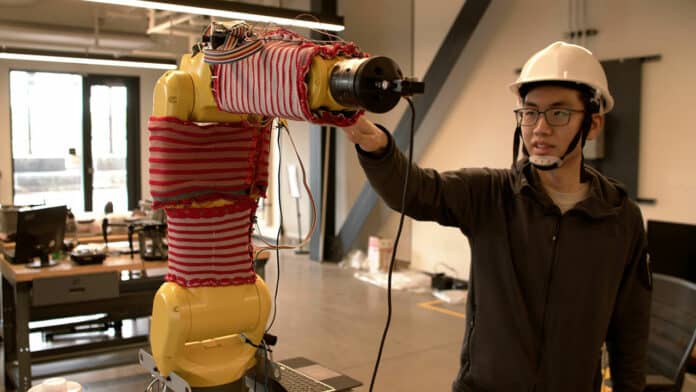Organisms have skin receptors that help them gather environmental information to react accordingly. Similarly, for robots to sense pressure, strain, shear force, temperature, proximity, texture, humidity, etc., tactile sensors such as skin benefit and fingertip tactile sensors that sense pressure on small areas are well developed. Although feeling contact information over large areas of a robot’s surface is still challenging, scalability and flexibility are the main obstacles.
Previous researchers have made successful industrial machine-knitted tactile sensors. However, those sensors suffer from non-robust and non-repeatable measurements caused by unmodeled internal deformation, which contact detection relies on.
A research team at Carnegie Mellon University’s Robotics Institute has developed the RobotSweater, a machine-knitted fabric “skin” that can sense contact and pressure. It is pressure-sensitive low-cost tactile skin that is scalable, generalizable, and customizable.
The knitted RobotSweater fabric can help the robot feel when a human touches it, particularly in an industrial setting where safety is paramount and can be customized to fit uneven three-dimensional surfaces. RobotSweater allows a push from a person’s hand to guide the arm’s movement while grabbing the arm and telling it to open or close its gripper.
The researchers fabricated the sensors using off-the-shelf conductive and non-conductive yarns on automated knitting machines. The researchers used a three-layer knitted-fabric structure for the tactile sensor design that sandwiched layers of insulating mesh between two layers of orthogonal piezo-resistive traces.
This design enabled the taxel units to be pressure-sensitive upon contact. It disconnected when there was no contact, ensuring accurate contact detection and localization that is critical for applications such as safe human-robot interaction.
RobotSweater can sense the distribution, shape, and force of contact. It is more accurate and effective than the visual sensors that most robots now rely on.
With the RobotSweater, the robot’s entire body can be covered to detect potential collisions when pressure is applied to the fabric. For example, when someone touches it, the conductive thread closes the circuit and is read by the sensors.
Journal reference:
- Zilin Si, Tianhong Catherine Yu, Katrene Morozov, James McCann, and Wenzhen Yuan. Robotsweater: scalable, generalizable, and customizable machine-knitted tactile skins for robots. arXiv, 2023; DOI: 10.48550/arXiv.2303.02858
